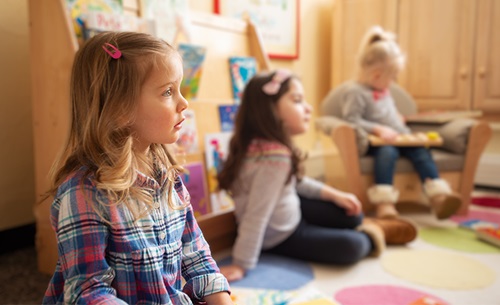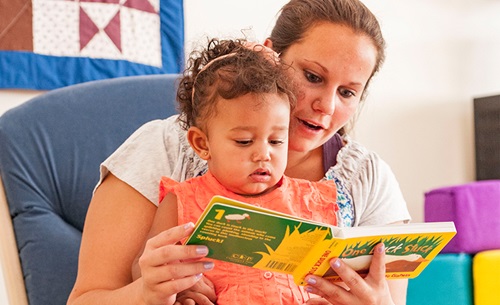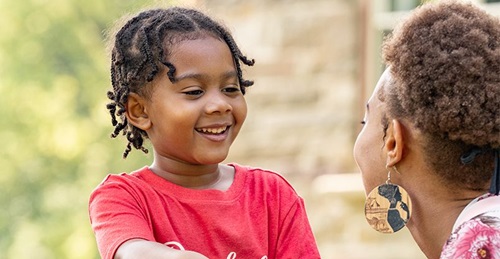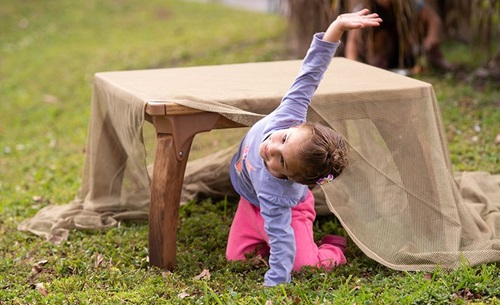Helping Children Cope with Stress
| August 2016Valerie has been teaching three year olds for the last fifteen years. Many of the children in her classroom live in single parent homes or alternate caregiving situations (like children living with grandparents). Families cope with unpredictable schedules, multiple jobs, and sometimes unstable housing situations, along with high crime rates in their neighborhoods.
As is true for many teachers, stress is a constant presence in her classroom—in the children she cares for, the families trying to make it work, and for herself, as she deals with the challenges of balancing their needs with the demands of her personal life.
In many ways, stress is a normal and unavoidable part of life. While all families want to see their children succeed, not all families have extensive emotional or financial resources to help children deal with stress at home. As an adult who spends many hours each day with children, what you do can have a wide reaching impact. Here are five strategies you can use to support young children in your classroom as they cope with stress.
1. Learn about the different kinds of stress.
The causes of stress are different for each individual, and dependent on many factors, ranging from temperament to home environment and previous experiences. The way children show signs of stress also varies widely. Understanding the physical and emotional responses to stress as separate from the sources and the expressions of stress can help you offer appropriate support in your classroom.
When we experience stress, all sorts of things happen in our bodies—our heart rate and blood pressure go up, and there is an increase in stress hormones like cortisol. Over time, these changes can cause permanent damage to the brain and body if the stress response is not mitigated, making the teaching task of supporting children experiencing stress crucial for long term development of the child.
The Center for the Developing Child at Harvard describes three kinds of responses to stress:
- Positive stress response is brief and quickly eased by supportive caregiving. A fall on a playground or a first day with a new teacher might cause this kind of response. Learning to cope with positive stress is an important developmental task, and one that teachers support daily with sensitive and attuned responses to children’s needs.
- Tolerable stress response is usually a result of a more severe, longer lasting event, such as the loss of a loved one, family upheaval, or serious health issue. The body’s response is more intense, but support by caring adults can ease this kind of stress, allowing children’s bodies and brains can return to normal without permanent damage or interruption in development.
- Toxic stress response occurs when children experience strong or ongoing adversity without the necessary support of caring adults. Examples of this kind of adversity include exposure to violence, mental illness of a primary caregiver, or prolonged family instability. This kind of stress can interrupt normal development of the brain and body and increase the risk for stress-related illnesses later in life.
Regardless of the type of stress or the response children experience, your consistent, supportive care makes a difference in the child's ongoing emotional and physical development.
2. Offer a predictable classroom routine.
Valarie begins each day the same way. She greets each child as he or she arrives, and then helps them choose a center for their first block of play time. She plays soft, cheerful music to set the tone. When it’s time for their morning meeting, she invites the children to join her in a circle on the rug, making a special place next to her today for Jaleel, who had a hard time saying goodbye to his dad this morning. They go over the lunch menu, talk about the weather, and she reminds them that they have a special visitor this afternoon—Maya’s grandmother is coming to read the class a story in Spanish and bringing a special snack.
Almost all children benefit from a predictable daily routine. When children are experiencing stress outside the classroom, your steady and predictable presence and routine can help them find calm and balance. With very young children, your daily routine should stay mostly the same from day to day. When you need to make changes, try to do it incrementally (for example, only rearranging one section of the classroom at a time).
Offer lots of reminders about what will happen next, using verbal and visual cues along the way. (More strategies about managing transitions can be found here.) Remember that your tone as a teacher is a crucial feature of your classroom—keeping your responses to events in the classroom predictable and calm reassures children that they are safe, and allows them to focus on playing and learning, despite stressful situations in other areas of their lives.
3. Observe children carefully to find patterns, identify causes, and offer care and support.
Regular observation is a good teaching strategy under any circumstances, but it’s particularly useful when children show signs that they are experiencing stress. All behavior has meaning, and young children often show us with their actions that they are having a hard time.
When a child is having a difficult time, avoid making assumptions about what might be going on. Write down what you see, stating the facts—who, what, when, where, and why—looking for patterns over time. This might allow you, for example, to pinpoint that on Monday mornings, a particular child almost always struggles. Knowing this, you might offer her additional support during that time by staying close to her and offering soothing activity choices as she transitions back into the school environment.
Valerie has been noticing that Joshua seems out of sorts. Lately, he’s been hitting, biting, and whining, along with other challenging behaviors that seem to be getting worse, despite her usual classroom strategies to redirect and correct them. When Valarie starts writing down every time Joshua acts aggressively or loses control, she sees that it almost always happens on Wednesdays and Fridays. She asks his mother, Michelle, to meet with her to see if they can figure out what might be going on.
A written record of observations can also help you partner with families to find out what might be going on with a child in your classroom. If your interventions don’t seem to help, it’s a good time to meet with family members and ask open ended questions that can help you work together to meet the child’s need and ease his response to stress.
Valerie shows Michelle her notes, highlighting the pattern that she’d noticed. Michelle tells her that a few weeks ago, she picked up a late shift waiting tables on Tuesday and Thursday nights. Joshua has been staying at a neighbor’s home those evenings—Michelle picks him up when she gets off work after midnight. The neighbor has no small children at home and the household stays up late—Joshua included.
Before Valerie brought it up, Michelle hadn’t realized the impact this schedule was having on Joshua. Michelle decides to ask her sister to stay with Joshua when she’s working late, trading childcare over the weekend. As Joshua’s bedtime routine returns to normal, he is able to manage much better in the classroom.
For more strategies for dealing with challenging behaviors while supporting emotional development, check out this article.
4. Accept and accommodate regression
Regression is a normal response to stress—for adults and children alike! Stress can make adults feel short-tempered, forgetful, and anxious (in short, like teenagers). Once our source of stress has resolved or we find new ways to cope with it, we’re usually able to bounce back, tackling day to day tasks without so much struggle.
When children experience stress, they may show signs of regression in one area (toileting, for example), or in many areas. They might have trouble getting along with friends they usually enjoy playing with, or accomplishing developmental tasks they could easily do previously. As a teacher, it’s important to meet a child where he or she is, offering support and compassion, and realizing that with time and support, most children will return to their previous level of ability when the source of their stress is resolved.
Jaqueline was fully toilet trained when she joined Valerie’s class right after her third birthday. Despite it being a new skill for her, she went months without ever having an accident. Suddenly, she begins having accidents almost daily. Valerie realizes that Jaqueline’s mother is just returning to work after giving birth to a new baby. The strain on the family is visible—her mother looks exhausted when she drops Jaqueline off in the morning.
Knowing how stressful it can be when a new baby joins a family and suspecting that it might be related to Jaqueline’s recent challenges, Valerie begins offering her more reminders about going to the toilet. She also asks Jaqueline’s mother to send an additional set of clothes, just in case, and incorporates books about big sisters and new babies into her reading time. After a few weeks, Jaqueline’s accidents become less frequent, and soon disappear altogether.
5. Become trauma informed.
There is a difference between stress and trauma. Trauma can change the physical structure of the brain, and can have a lifetime of emotional, social, and physiological implications. Children who have experienced major trauma may react differently to normal environments—overreacting or underreacting to stimulation, experiencing extreme fear which may manifest as aggression, or struggling to manage social situations, as examples. They also may not respond to traditional discipline strategies in the way that other children do.
If you know or suspect that child in your care has experienced significant trauma, avoid making any assumptions, but be prepared to offer additional support in your classroom. If possible and appropriate, reach out to families to learn if there are specific ways you can align your teaching with the care a child is receiving outside the classroom.
Valerie has a new child in her classroom. Jackson and his mother just moved in with his grandmother, fleeing a dangerous domestic violence situation. His grandmother told her a little about the situation when he was enrolled, and cautioned Valerie to be very careful not to include pictures of him on any social media, for safety reasons.
Jackson is very quiet—he doesn’t talk to the other children, and only talks to Valerie when she asks him questions directly. He often stares into space, but jumps visibly at loud noises. On the playground, he is quick to push or hit when other children get too close, and he struggles to ask for help when a task is too hard.
Valerie realizes quickly that she will need more strategies to help Jackson feel safe in his new environment. When she asks Jackson’s mother how she can best support their family, she finds out that Jackson is seeing a play therapist, who has offered some teacher resources. She tells Valerie that Jackson feels best when he can see the whole room at once, when a trusted adult stays close by, and when he doesn’t go too long between snack breaks.
Valerie makes a plan to keep Jackson close to her during the day as much as possible, give him extra reminders about transitions, and provide him with extra support as he works to make friends. She also plans to connect regularly with Jackson’s family, to see how things are going and make adjustments as they are needed.
For more ideas about supporting children in your classroom who have experienced trauma, check out this practical resource. There are many other resources available—taking time to learn more can help you match your response with the needs of children in your care.
When you use these strategies in your classroom, you are helping children to build skills and resilience that can serve them over the course of their lives as they deal with the inevitable challenges that come with growing up. Your day-to-day support makes a difference!
References:
Albrecht, K. & Forrester, M. (2014). Social emotional tools for life: An early childhood teacher’s guide to supporting strong emotional foundations and successful social relationships. Korea: Innovations in ECE Press.
Center on the Developing Child: Harvard University (n.d.). Toxic stress. Retrieved from http://developingchild.harvard.edu/science/key-concepts/toxic-stress/.
Maliza, A. & Nutt, D. (2004). Structural and functional brain changes in post-traumatic stress disorder. Journal of Clinical Psychiatry, 65 Supl. 1: 11-7. Abstract retrieved from http://www.ncbi.nlm.nih.gov/pubmed/14728092.
We are Teachers. (2016, February 24). 10 things about childhood trauma every teacher needs to know. Retrieved from http://www.weareteachers.com/blogs/post/2016/02/24/10-things-about-childhood-trauma-every-teacher-needs-to-know.







